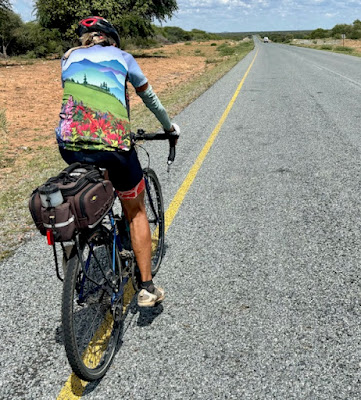by Henry
156 km, 432 m total ascent, 27°C maximum.
Sun rising over breakfast. We had to be cautious with the usual city traffic as we departed Maun. There are many cars, but hardly any motorcycles.
Streetside purveyor of seemingly random goods: dog houses, firewood, metal, lockboxes, and metal pans. We no longer see bags of charcoal being sold in Botswana.
I didn’t know how to pronounce the “nx” combination, and asked one of our African TDA staff members. He taught me how to pronounce it and there’s no phonetic spelling for it in English. It involves a clicking sound with the tongue on the roof of the mouth.
Cinderblock construction is prevalent in the city. In the countryside, some adobe buildings with thatched roofs appear.
They are very few humans on this stretch of Botswana road. We are kept company by donkeys . . .
. . . and cattle (smallish herds, compared to what we saw in other countries).
We saw some Herero women by the side of the road with their characteristic horned hats and colorful petticoats. Their clothing style is derived from the German missionaries and colonialists who came to Namibia in the 1890s. There was a German genocide of the Herero people from 1904 to 1908.


Towards the end of the day, a glimmer of a hill appeared, to break up the monotony of the flats.
We had a steady tailwind for almost the whole day, which accelerated our progress.
This is our last bush camp of the Tour. Accordingly, we had our final “stand-in-the-blue-bucket” shower; I doubt anybody is too sad about that.
This is our last bush camp of the Tour. Accordingly, we had our final “stand-in-the-blue-bucket” shower; I doubt anybody is too sad about that.
We were forewarned that in prior years, puff adder snakes have been spotted at this campsite, and we are encouraged to wear closed shoes. The campsite was instantly christened “The Snake Pit”.

Our campground was dominated by one large baobab tree, and the earlier arrivals secured prime tent sites in its shade.
Arborization pattern of the baobab.
At the rider meeting tonight, we not only talked about tomorrow, but Colleen touched on the complex logistics of the 217 km ride 2 days hence.
Without light pollution, the desert night sky is completely loaded with stars. The constellations are foreign to me in the southern hemisphere.
The nocturnal air is still and dry. No mosquitoes are buzzing as they cannot breed or survive in this arid climate.








No comments:
Post a Comment